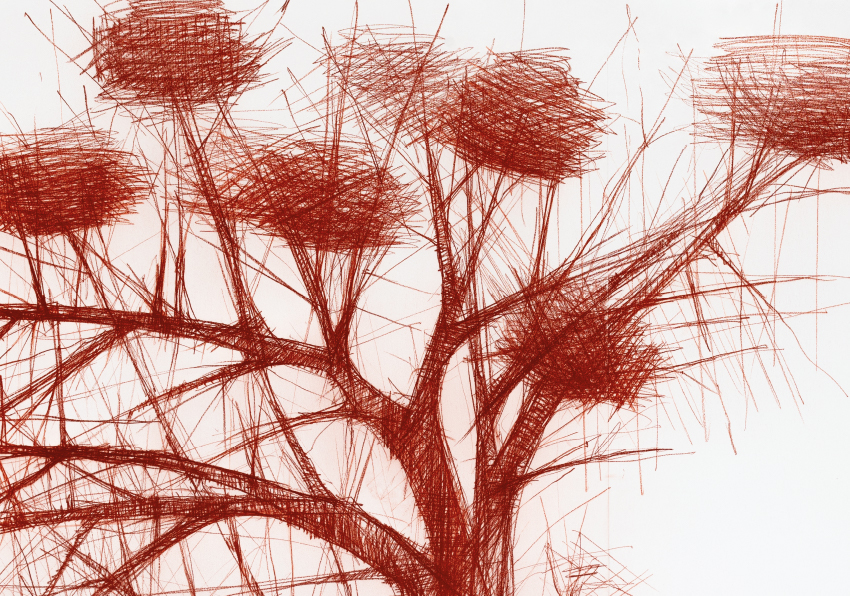
Scenery and climate change. Transformation of sight.
Choosing nature as a scenery to express the deep feelings that art bring to the conscience and reflection on our present. Terrain and artistic subjectivity cannot be severed. The author recreates the scenery and observer contemplates and expresses the perception according to their own experience and historical and cultural conceptualisation. The aesthetic meaning and narrative lines intertwine and condition our sight.
Overcoming the limitations of a canvas, the insight on shapes, silhouettes, colours and visions transcending the work of Calo Carratalà connects us to sensitive highlights that breathe emotion into us. Joy and overwhelming are faced with the immensity, the foreshadowing, the vulnerability. In our time, the sublime drowns into the consequences of the incurable impact and unstoppable disease we pose onto the planet.
Climate change consequences are undeniable and our vision regarding the environment makes evident the timesickness of loss. Thoughts of transformation linked to the realisation of environmental conscience, natural resources scarcity and social justice emerging urgently.
Contemporary scenerism has also changed its codes: it is one of the most fertile research fields within the art practice. If previous eras had artists discovering world sceneries, current artist seem to be preserving them. The scenery to be protected prevails against the one to be discovered that inspired the romantic spirit of the 19th century. In the last decades we have seen a reconfiguration of the scenery due to its discontextualisation. Nowadays, the receive new connotations and turn into objects of aesthetic ecology and ethical consideration.
For British painter and theorist John Berger, art’s value is based on its representation of the existence via which humans gain conscience of what is happening as well as life itself and the responsibility of the cosmos. Artists delve into the knowledge without desecrating its mysteries, keeping its secret without vain blabbering.
Living a scenery, feeling it and narrating it from the symbolic value it holds is an aesthetic experience that also means preserving its memory. The work of Carratalà is a transgression to naturalism to represent the idea, the poetic element from a profound insight, a sort of alchemical spirit contained in matter that outlives the ephemeral.
Calo Carratalà was born in Torrent (Horta Sud), and has been working on the scenery field since his first steps. An academically firm painter with a vast number of exhibitions since the early 90s, his name is a reference in Spain’s contemporary scenerism. He has painted a great amount of sceneries from cities, surrounding areas and, since decades ago, he travels thousands of kilometres to experience the distance and showcase hidden and overwhelming nature. This exhibition shows an impressive light from Africa radiating from his paintings and drawings after remaining for months in Tanzania and Senegal. During that time, he visited the same places in different moments and filled up his sketchbook with notes and scribbles he later translated into his canvas to create a thematic series.
Combining work, genius, skill and technique with research, his painting from then on became lively with modern and historical scenerism codes within a means of visual and conceptual exploration.
Marisa Giménez Soler
The scenery surprises us and reveals new aspects we previously didn’t know. It also invites us to reflect on the complexity and diversity of our world. Its vastness and variety makes it a powerful catalyst of inspiration and learning.
The most current environmental crisis brought by “homo sapiens” in jungles, coasts and baobabs is showcased by Calo light subtly and objectively with critical sensitivity over man-made torment on scenery, nature and themselves.
We live in a sublime era drowning in the consequences of the unforgivable damage we put our planet through. Climate change consequences are undeniable and out vision regarding the environment makes evident the timesickness of the loss.
Carratalà composes his baobab with the sanguine technique on white background and immense formats to showcase their singularity and their wounded beauty, since many of these venerable trees keep dying mysteriously in Africa. The wish of repeating the image is, in fact, a reflection on the revealing and echo of their vulnerability.











